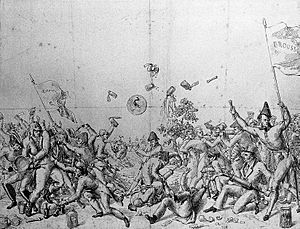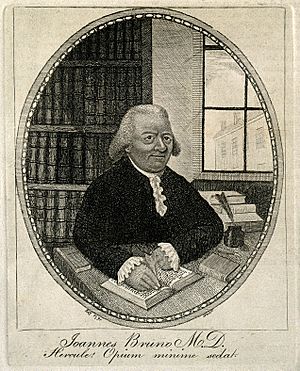John Brown (physician, born 1735) facts for kids
Quick facts for kids
John Brown
|
|
|---|---|

John Brown
|
|
| Born | 1735 Berwickshire, Scotland
|
| Died | 17 October 1788 (aged 52–53) London, England
|
| Education | University of Edinburgh |
| Occupation | Doctor |
| Known for | Creator of the Brunonian system of medicine |
John Brown (1735 – 17 October 1788) was a Scottish physician. He created a new way of thinking about medicine called the Brunonian system of medicine.
Contents
Early Life and Education
John Brown was born in Berwickshire, Scotland, in 1735. His father was a simple worker. Even though his family didn't have much money, John got a great education in classic subjects from Mr. William Cruickshank. He was very good at Latin and started reading the Old Testament by age five. People who knew him said he was very smart and sensitive from a young age.
Because his family was poor, he had to leave school in Duns, Scottish Borders. He then became an apprentice to a local weaver. This was a tough life for someone who loved learning so much.
Journey to Medicine
At age twenty, John Brown left his weaving job and went to Edinburgh. He started studying religion at the University of Edinburgh. To support himself, he worked part-time as a private teacher.
In 1759, he stopped studying religion and began to study medicine. He became a private teacher for the family of William Cullen, a very famous doctor in Edinburgh. Brown also helped Cullen with Latin documents and was almost like an assistant professor. In 1761, Brown joined the Royal Medical Society in Edinburgh.
Developing New Ideas
John Brown took part in many lively discussions at the Royal Medical Society. These talks were about new ideas in medicine. Over time, Brown started to form his own ideas about life and illness. These ideas were different from those of his mentor, William Cullen.
This led to disagreements between Brown, Cullen, and other university professors. However, many students supported Brown's new ways of thinking. Because of this opposition, Brown started giving his own public lectures. In these talks, he criticized older medical systems, including Cullen's.
Brunonian System of Medicine
In 1780, John Brown published his main book, Elementa Medicinae. This book explained his new medical ideas, which became known as the Brunonian system of medicine. He believed that all diseases were caused by too much or too little "stimulation" in the body.
Brown thought that outside factors could excite the body. This excitement could lead to different diseases and symptoms. He called too much stimulation the sthenic state and too little stimulation the asthenic state.
- For sthenic diseases (too much stimulation), Brown suggested treatments like vomiting, cold air, and purging.
- For asthenic diseases (too little stimulation), he prescribed things like opium, roast beef, and alcoholic drinks. (Note: Modern medicine does not recommend these treatments.)
Brown's system was meant to simplify medicine. It didn't require deep knowledge of anatomy or linking specific symptoms to certain diseases. Because it was simpler, many doctors could use it. This made it very popular in places like Germany.
Impact in Europe
Brown's medical ideas became very popular for several decades, especially in Italy and Germany. In Germany, doctors were looking for new, scientific ways to explain diseases. Brown's theory, which linked the outside world to the body's reactions, fit this need.
His book, Elementa Medicinae, was translated into German in 1795. Many other translations followed. A student named Andreas Röschlaub helped introduce Brown's work to German academics. Röschlaub even worked with another doctor to create a new medical system based on Brown's ideas. This system was used in a hospital in Bamberg, which became an important center for medicine.
However, not everyone agreed with Brown's ideas. There were big arguments between those who supported Brunonian medicine and those who didn't. In 1802, about 400 students even rioted in Göttingen over these disagreements. Some writers, like August von Kotzebue, wrote plays that made fun of Brunonian medicine.
After 1809, discussions about John Brown's system started to fade. While it was briefly mentioned during a typhoid outbreak in 1813–1814, by 1817, it had few supporters. However, it saw a brief return in the 1820s when a French doctor, François-Joseph-Victor Broussais, became famous for his similar ideas.
Later Life and Death
In 1786, John Brown moved to London hoping to improve his financial situation. Sadly, he faced money problems and died on October 17, 1788, at the age of fifty-two. He passed away shortly after his main work, Elements of Medicine, was published in English.
In 1789, a student named William Margetson Heald wrote a poem called The Brunoniad. It was a humorous poem about Brown.
Legacy
In 1795, a new version of Brown's Elements of Medicine was published by Thomas Beddoes. The money from this book helped Brown's wife and children. In 1804, all of Brown's works were published, along with a biography written by his son, William Cullen Brown.
John Brown was the grandfather of the artist Ford Madox Brown. He was also the great-great grandfather of the famous novelist Ford Madox Ford.
|



